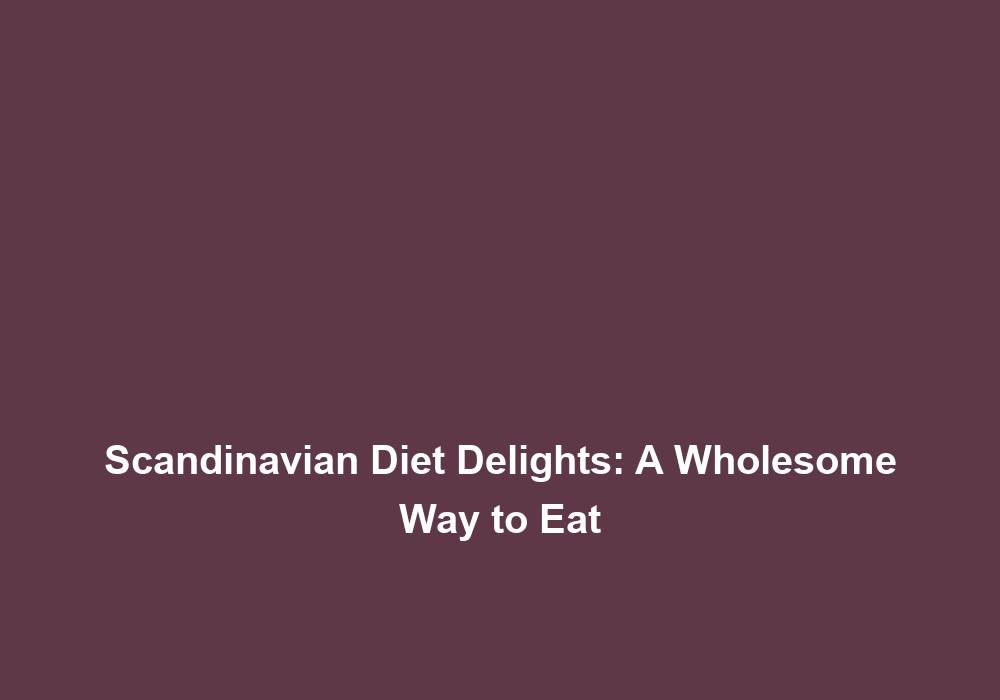Scandinavian Diet Delights: A Wholesome Way to Eat
The Scandinavian Diet, also known as the Nordic Diet, has gained significant popularity in recent years. This way of eating focuses on embracing wholesome, nutrient-rich foods that are commonly found in Scandinavian countries such as Denmark, Sweden, Norway, Finland, and Iceland. With its emphasis on fresh, local ingredients and simple preparation methods, the Scandinavian Diet offers a wonderful approach to nourishing your body while enjoying delicious and satisfying meals.
Embracing Local and Seasonal Foods
One of the core principles of the Scandinavian Diet is the use of local and seasonal ingredients. This approach ensures that you are consuming fresh produce that is at its peak in terms of flavor and nutritional value. By supporting local farmers and businesses, you also contribute to sustainable food practices and reduce your carbon footprint.
Including a variety of fruits, vegetables, whole grains, and legumes is essential in the Scandinavian Diet. These ingredients provide a rich source of vitamins, minerals, fiber, and antioxidants, promoting overall health and well-being. Aim to include vibrant berries, root vegetables, leafy greens, and whole grains in your meals to reap the diverse range of nutrients offered by these foods.
Some specific examples of local and seasonal foods in Scandinavian countries:
- Berries: Scandinavia is known for its abundance of berries, such as lingonberries, cloudberries, and bilberries. These berries are packed with antioxidants, vitamins, and fiber, providing numerous health benefits.
- Root vegetables: Carrots, turnips, and parsnips are commonly used in Scandinavian cuisine. They are rich in vitamins, minerals, and dietary fiber, supporting digestion and providing a good source of energy.
- Leafy greens: Kale, spinach, and collard greens are nutritious leafy greens that are often included in Scandinavian dishes. They are high in vitamins A, C, and K, as well as folate and iron.
- Whole grains: Rye, oats, barley, and spelt are staple grains in Scandinavian cooking. These whole grains are excellent sources of fiber, helping to regulate blood sugar levels and promote a healthy digestive system.
Prioritizing Fish and Seafood
Scandinavian countries are surrounded by the North Atlantic Ocean and the Baltic Sea, making fish and seafood an integral part of their traditional cuisine. Including fatty fish like salmon, mackerel, and herring in your diet provides an excellent source of omega-3 fatty acids, which offer numerous health benefits, including reducing inflammation and supporting heart health.
Incorporating fish and seafood into your meals a few times a week can not only enhance your diet’s nutritional profile but also add variety and flavor. Try incorporating grilled or baked fish into salads, making fish soups, or enjoying traditional Scandinavian dishes like smoked salmon open-faced sandwiches.
Some additional benefits of including fish and seafood in your diet:
- Omega-3 fatty acids: Fatty fish are rich in omega-3 fatty acids, which are essential for brain health, reducing the risk of heart disease, and supporting overall well-being.
- Protein: Fish and seafood are excellent sources of high-quality protein, necessary for muscle repair and growth.
- Minerals: Fish, such as salmon, is rich in minerals like selenium, potassium, and iodine, which are important for various bodily functions.
Savoring Whole Grains and High-Fiber Foods
The Scandinavian Diet places a strong emphasis on whole grains and high-fiber foods. These nutrient-dense foods provide sustained energy, improve digestion, and contribute to feelings of fullness and satiety. Whole grains like rye, oats, barley, and spelt are commonly enjoyed in Scandinavia and can be used in a variety of recipes.
To incorporate more whole grains into your diet, consider starting your day with a hearty bowl of Scandinavian-style porridge made with oats or barley. You can also experiment with baking bread using different whole grain flours, opting for rye bread or crispbread as a nutritious alternative to refined wheat products.
Additional benefits of whole grains and high-fiber foods:
- Fiber: Whole grains and high-fiber foods promote healthy digestion, prevent constipation, and help maintain a healthy weight.
- Nutrients: Whole grains are rich in essential vitamins and minerals, such as B vitamins, iron, and magnesium, which play a vital role in maintaining overall health.
- Blood sugar control: The fiber content in whole grains helps regulate blood sugar levels, making them a suitable choice for individuals with diabetes or those looking to manage their blood sugar levels.
Incorporating Healthy Fats
Including healthy fats in the Scandinavian Diet is encouraged, as they provide essential fatty acids and contribute to satiety. Nuts, seeds, avocados, and cold-pressed oils such as rapeseed oil and extra virgin olive oil are commonly used in Scandinavian cooking.
Adding a handful of nuts or seeds to your meals and snacks can boost the nutritional value and add a satisfying crunch. Consider using rapeseed oil in salad dressings or as a cooking oil, as it is rich in omega-3 fatty acids and has a pleasant, nutty flavor. Remember to use fats in moderation, as they are calorie-dense.
Some examples of healthy fats to include in your diet:
- Nuts and seeds: Almonds, walnuts, chia seeds, and flaxseeds are excellent sources of healthy fats. They also provide protein, fiber, and essential vitamins and minerals.
- Avocado: Avocado is a versatile fruit that is rich in monounsaturated fats, which can help lower bad cholesterol levels and reduce the risk of heart disease.
- Cold-pressed oils: Rapeseed oil and extra virgin olive oil are healthy oils that can be used in cooking or as dressings. They are high in monounsaturated fats and contain beneficial antioxidants.
Moderate Consumption of Dairy and Fermented Foods
Dairy products and fermented foods play a significant role in the Scandinavian Diet. However, it is important to consume them in moderation, especially if you have lactose intolerance or any dairy-related allergies. Opt for low-fat or natural yogurt, cottage cheese, and small portions of artisanal cheeses.
Fermented foods like sauerkraut, pickles, and kefir can also be beneficial for gut health due to their high probiotic content. These foods are known to support digestion and enhance the absorption of nutrients. Experiment with incorporating fermented foods as condiments or side dishes to complement your meals.
Some tips for incorporating dairy and fermented foods:
- Choose low-fat or natural yogurt: Natural yogurt is a good source of calcium and protein. Opt for plain yogurt and add fresh fruits or a drizzle of honey for sweetness.
- Try different types of cheeses: Instead of consuming large portions of cheese, enjoy small portions of artisanal or high-quality cheeses to savor the flavors without overindulging.
- Include fermented foods as condiments: Add sauerkraut or pickles to your sandwiches or serve them as a side dish to boost your gut health.
Exploring Traditional Scandinavian Dishes
Scandinavian cuisine offers a myriad of traditional dishes that are both flavorful and nutritious. Some examples include:
- Smørrebrød: Open-faced sandwiches topped with a variety of ingredients such as smoked fish, pickled herring, or cold meats. These sandwiches are a popular lunch option and can be customized with different toppings.
- Gravlax: Cured salmon traditionally marinated in a mixture of salt, sugar, and dill. It can be served as an appetizer or in sandwiches. Gravlax is a delicacy in Scandinavian cuisine and is often enjoyed during festive occasions.
- Köttbullar: Swedish meatballs made with a blend of ground meat, breadcrumbs, and spices. They are often served with lingonberry sauce and potatoes. Köttbullar is a classic dish that can be enjoyed as a main course or as part of a buffet.
- Lohikeitto: Finnish salmon soup made with fresh salmon, root vegetables, and dill. It is a comforting and nutritious dish that is popular during the colder months. Lohikeitto is often served with rye bread.
- Rye bread: A staple in Scandinavian cuisine, rye bread is dense, flavorful, and rich in fiber. It is often enjoyed with toppings like cheese, smoked salmon, or pickled herring.
Conclusion
The Scandinavian Diet offers a wholesome and delicious way to nourish your body. By embracing local and seasonal ingredients, prioritizing fish and seafood, incorporating whole grains and high-fiber foods, and savoring healthy fats, you can enjoy a nutrient-rich diet that promotes overall health and well-being. Don’t forget to explore traditional Scandinavian dishes to truly immerse yourself in this delightful culinary journey.







